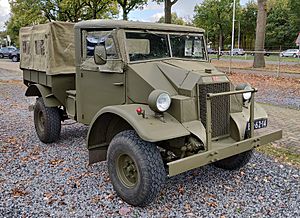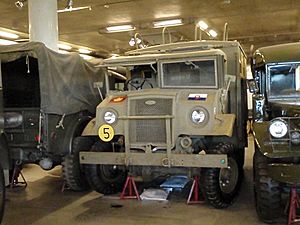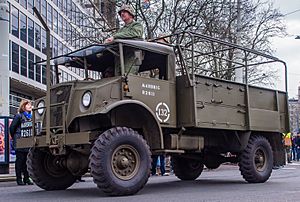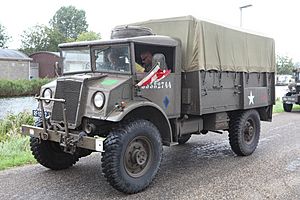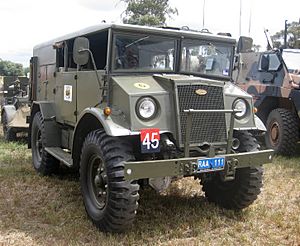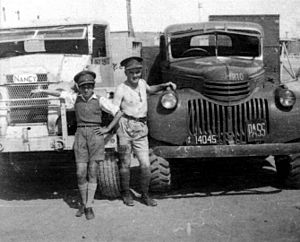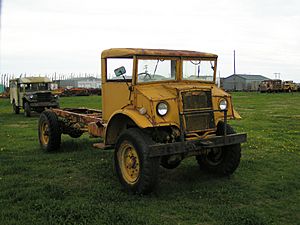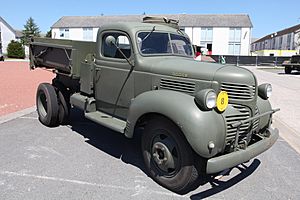Canadian Military Pattern truck facts for kids
Quick facts for kids Ford F15 |
|
|---|---|
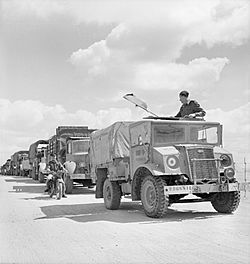
A Ford F15 (4x2) leading an RAF convoy in North Africa
|
|
| Type | 3 ton 4x4 Cargo |
| Place of origin | General Motors of Canada Limited Ford and Chrysler Canada |
| Service history | |
| In service | From 1940 |
| Wars | World War II |
| Production history | |
| Designer | General Motors Canada and Ford Canada |
| Designed | 1936–1940 |
| Manufacturer | Chevrolet in Oshawa and Ford |
| Produced | 1940–1945 |
| No. built | 500,000+ Service Flag 3298 for Employees of Canada's Armed Forces |
| Specifications (Ford F15) | |
| Mass | 7,875 lb (3.572 t) |
| Length | 204 in (5.18 m) |
| Width | 84 in (2.13 m) |
| Height | 116 in (2.95 m) |
|
|
|
| Engine | Chevrolet GM 216 216 cu in (3.5 L) petrol I6 or Ford 239 239 cu in (3.9 L) petrol V8 GM: 85 hp (63 kW) Ford: 95 hp (71 kW) |
| Suspension | Wheel 4x4 |
| Maximum speed | 50 mph (80 km/h) |
Canadian Military Pattern (CMP) trucks were special military trucks made in huge numbers during World War II. They were built by big car companies in Canada, like Ford, General Motors (GM), and Chrysler. These trucks were designed to meet specific rules from the British Army. They were mainly used by armies from the British Commonwealth (countries like Canada, Australia, and New Zealand that were once part of the British Empire).
Canada made about 850,000 vehicles during World War II. Most of these, over 800,000, were trucks and light vehicles. These trucks were very important because they helped move soldiers and supplies for the Allies.
Before the war, Canada started planning standard designs for military vehicles. This led to a unique teamwork effort between rival car makers, especially Ford Canada and GM of Canada.
CMP trucks helped armies from Britain, Canada, Australia, and New Zealand. They were also sent to the Soviet Union to help fight the Nazis. This was part of Canada's "Gift and Mutual Aid program," similar to the U.S. Lend-Lease Act.
During the war, CMP trucks were used all over the world. They saw action in places like North Africa, Italy, the Eastern Front, Burma, and during the liberation of Europe. After the war, they were still used in conflicts in Indonesia and other places.
The official History of the Second World War from the United Kingdom said that Canada's production of these trucks was its most important help to winning the war. It's often said that Canada's trucks "put the British Army on wheels." In the North African Campaign, the British Eighth Army relied almost completely on CMP trucks. By the end of the war, Canada's huge supply of trucks meant there was one vehicle for every three soldiers, making it a very mobile army.
Contents
How These Trucks Were Developed
The idea for these military vehicles came from talks between the British War Office and the Canadian Army in the mid-1930s. This was after Hitler and the Nazi party came to power in Germany in 1933. It was important that any military equipment made in Canada could work with British equipment.
In 1937, Ford Motor Company of Canada and General Motors of Canada Ltd were asked to create a Canadian version of a light military truck. By 1938, the Canadian military wanted heavier 4x4 and 6x4 trucks. They asked Ford and GM to make prototypes of a medium artillery tractor.
By 1939, plans were ready to mass-produce a range of military vehicles in Canada. These vehicles had to follow strict British rules, known as the CMP (Canadian Military Pattern) specifications. At first, they were called "Department of National Defence (DND) Pattern" trucks. But as more were made and sent to other countries, they became known as "Canadian Military Pattern" trucks. When World War II started, Canada's car industry quickly switched to making military vehicles.
These trucks were first meant for the Canadian military. But after the Dunkirk evacuation in 1940, the British Army lost most of its vehicles in France. There was a huge need for new vehicles to equip the growing armies of the Commonwealth. CMP vehicles, with their large production capacity, were the perfect solution.
Making the Trucks
Canadian factories made about 850,000 vehicles during World War II. This included around 50,000 armored vehicles and tanks. But the most important were the more than 800,000 trucks and light vehicles. These were built by Ford, General Motors, and Chrysler of Canada. Canada's car industry was so good that it built more military trucks than Germany, Italy, and Japan combined.
Most CMP trucks were made by the Canadian Chevrolet division of General Motors and Ford Motor Company of Canada. These companies used their extra factory space from before the war. They also worked together in an unusual way, sharing parts that could be used in either company's trucks.
Many CMP trucks were assembled in Canada, then taken apart, packed into crates, and shipped overseas. They were then put back together in places like Britain, Australia, New Zealand, South Africa, India, Italy, and Egypt. Even though most were built in Canada, they had right hand drive, like British vehicles.
The CMP design was very flexible. It was used to make many different types of trucks and even some armored vehicles. There were over ninety types of CMP army vehicles, including wireless trucks, ambulances, and mobile workshops. In Australia, they were often called the "Chev Blitz" or "Ford Blitz."
About 410,000 CMP trucks were made in Canada. GM made 201,000, and Ford made the rest. The most common types were 4x4, 3-ton trucks. Chrysler also made about 180,000 Dodge trucks for the CMP role. These Dodges had their own cabs and were mostly two-wheel drive.
Canada's production of CMP trucks alone was more than the total military truck production of Nazi Germany. The official British history of the war says that making these trucks was Canada's most important contribution to the Allied victory.
After 1945, many CMP trucks were used by armies in Europe and around the world. They were also changed for civilian jobs like forestry, transporting grain, fighting fires, and clearing snow.
Types of Canadian Military Pattern Trucks
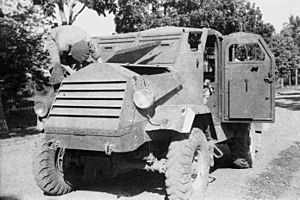
Ford-built CMP trucks used a 95 bhp (71 kW) Ford V8 Flathead engine. Most Chevrolet-built CMP trucks had an 85 bhp (63 kW) straight-6 engine. A larger GMC straight-6 engine powered the C60X 3-ton truck.
The Ford and Chevrolet trucks shared a standard cab (the driver's area) design. This design changed over the years. The first three designs were called No. 11, 12, and 13. The No. 13 cab, made from late 1941, had a special design. Its windscreen (windshield) was angled slightly downward. This helped reduce glare from the sun and prevented strong reflections that enemy aircraft could see.
All CMP cabs had a short, "cab forward" design. This gave the trucks their unique "pug-nosed" look. This design was needed to meet British rules for a compact truck. A compact truck was easier to transport by ship. The rules also required right hand drive.
Inside, the cab was a bit cramped because it had to fit the large North American engines. Chevrolet trucks could be identified by a diamond pattern on their radiator grille. Ford trucks had a square mesh grille.
Dodge trucks started production later. They used their own commercial cabs, which were longer. This helped speed up production. However, they still had right-hand drive (except for those used in Canada) and a gunner's hatch in the roof.
Smaller companies in Ontario and Manitoba built the bodies for the CMP trucks. These companies formed the "Steel Body Manufacturers Association" during the war. Many different body designs were made, including:
- General service (GS) / troop carrier
- Fuel / water tanker
- Vehicle recovery (tow truck)
- Field ambulance
- Mobile laundry
- Wireless house (radio HQ)
- Artillery tractor
The military used a system to describe the trucks. NxM means the vehicle has N total wheels, and M of those wheels are driven. For example, 4x4 means it has four wheels, and all four are driven. The British load capacities were 8 cwt (400 kg), 15 cwt (760 kg), 30 cwt (1,525 kg), and 60 cwt (3,050 kg). The 60-cwt trucks were usually called 3-ton trucks.
Chevrolet and General Motors Models
- Chevrolet C8 (4x2, 8 cwt)
- Chevrolet C8A Heavy Utility Truck (4x4, 8 cwt) - Used as Wireless, Ambulance, Personnel, and mobile repair shops.
- Chevrolet C15 (4x2, 15 cwt)
- Chevrolet C15A (4x4, 15 cwt)
- Chevrolet C15TA Armoured Truck (4x4, 15 cwt)
- Chevrolet C30 (4x4, 30 cwt)
- Chevrolet C60S (4x4, 3 ton)
- Chevrolet C60L (4x4, 3 ton)
- Chevrolet C60X (6x6, 3 ton, with a GMC straight-6 engine)
- Chevrolet CGT Field Artillery tractor (4x4)
CMP chassis were also used for armored cars. For example, the Fox Armoured Car was a British Humber Armoured Car design built by GM. General Motors Canada also built 1,761 Otter Light Reconnaissance Cars.
Ford Models
| Model | Drive | Wheelbase | Rating | |
|---|---|---|---|---|
| Ford F8 | 4x2 | 101 in (2.6 m) | 8 cwt | |
| Ford F15 | 4x2 | 101 inch | 15 cwt | |
| Ford F15A | 4x4 | 101 inch | 15 cwt | |
| Ford F30 | 4x4 drive | 134.25 in (3.41 m) | 30 cwt | |
| Ford F60S | 4x4 | 115 in (2.92 m) | 3 ton | |
| Ford F60L | 4x4 | 158.25 in (4.02 m) | 3 ton | |
| Ford F60T | 4x4 | 115 inch | 3 ton | tractor unit |
| Ford F60H | 6x4, rear axle undriven | 160.25 in (4.07 m) +52 inch | 3 ton | |
| Ford FGT | 4x4, | 101.25 inch | Field artillery tractor |
The Ford Lynx Scout Car was another vehicle built on a CMP chassis. It used the body of a Daimler Dingo.
Dodge (Chrysler Canada) Models
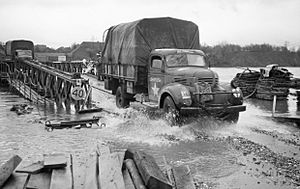
Chrysler of Canada made about 180,000 Dodge military trucks from 1939 to 1945. Most of these were 3-ton models. These trucks were mostly two-wheel drive. Only about 3,000 Dodge D8As and 11,750 Canadian-built versions of the 3⁄4‑ton WC-52 were four-wheel drive.
All Dodge trucks used Chrysler straight-six flathead gasoline engines. The D60 models' engine made 95 hp (71 kW).
| Model | Drive | Wheelbase | Rating |
|---|---|---|---|
| Dodge D8A | 4x4 | 8 cwt | |
| Dodge D15 | 4x2 | 128 in | 15 cwt |
| Dodge D60S | 4x2 | 136 inch | 60-cwt |
| Dodge D60S/DD | 4x2 | 136 inch | 60 cwt |
| Dodge D60L | 4x2 | 160 inch | 60 cwt |
| Dodge D60L/D | 4x2 | 160 inch | 60 cwt |
| Dodge D60L/DD | 4x2 | 160 inch | 60 cwt |
CMP Trucks Around the World
Chassis (the truck's frame and engine) and vehicle production was also allowed in Australia. Other vehicles were shipped to Britain as "knocked down" kits. This meant they were partly assembled, then taken apart, shipped, and put back together in factories in Britain.
Special versions were made to be "air-portable." Their top parts could be removed and stored so the trucks would fit inside transport aircraft. These parts could then be easily put back on when the trucks arrived.
Bare chassis were also sent to India. This reduced shipping space. Bodies for these trucks were then built locally in India, often using wood. This created many different "Indian Pattern" vehicles.
To meet the urgent need for military vehicles, several Commonwealth countries designed light armored vehicles using Canadian-made CMP chassis. Special chassis were even made with engines at the back and steering in the middle for these armored cars.
Some examples of vehicles built on CMP chassis outside Canada include:
- Rover Light Armoured Car (Australia)
- Rhino Heavy Armoured Car (Australia) - a prototype
- Armoured Carrier Wheeled Indian Pattern (India)
- Marmon-Herrington Armoured Car (South Africa)
- Beaverette NZ (New Zealand version of a British armored car)
- C8AX "Puddlejumper" (New Zealand)
Many Indian Pattern vehicles also had armored bodies, turning them into armored trucks.
See also
- List of military equipment of the Canadian Army during the Second World War
- CMP FAT
- Morris C8 Field Artillery Tractor
- Military history of Canada during the Second World War


